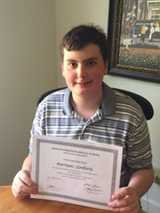Motility Disorder: Harrison’s Story
Motility Disorder: Harrison’s Story
Harrison, 14, has struggled with constipation and digestive problems throughout his entire life, resulting in an enlarged colon. Treatment from the Lustgarten Center for GI Motility at Children’s Hospital of Philadelphia has his digestive system working normally, and his colon is healing.

Harrison was troubled by motility disorders all throughout his childhood. Ever since he was a baby, he suffered from constipation and uncomfortably large and messy bowel movements. Over time, his discomfort developed into an aversion to going to the bathroom, which made the problems even worse.
His mother, Barbara, sought help from a wide range of experts. “I tried everything,” she remembers. “Over the course of 13 years, we went to 20 different doctors.” But the physicians’ recommendations did not bring Harrison any relief.
When Harrison reached adolescence, his motility issues began to interfere more seriously with his quality of life. He missed almost five weeks of school when he was 13, and his problems were affecting his social life.
Finding hope at Children’s Hospital
Barbara’s friend recommended that she bring Harrison to Kristin N. Fiorino, MD, at Children’s Hospital of Philadelphia (CHOP). Dr. Fiorino is a a pediatric gastroenterologist in CHOP's Lustgarten Center for GI Motility. The center brings together specialists in gastroenterology, nutrition and psychology to diagnose motility problems, provide therapeutic treatment, and coordinate patients’ care.
“I was apprehensive going in,” Barbara recalls. Harrison had seen many doctors throughout the years without many improvements. But she was pleasantly surprised by Dr. Fiorino. “She was very helpful, even in our first meeting. She analyzed the situation and explained the tests that she wanted to do. And she was able to interact well with Harrison, who has autism spectrum disorder.”
Dr. Fiorino proposed a Sitz test, in which the patient swallows a capsule with markers that are visible in an X-ray. Images taken over time show how the markers move through the digestive system.
“I had never heard of the Sitz test before,” say Barbara. “None of the doctors we had seen had mentioned it. But I agreed to it.”
“And that was the beginning of the miracle for us.”
Discovering the problem
More About Motility Disorders
The images revealed that Harrison’s colon was greatly enlarged — years of pressure had stretched it to an unhealthy size. The images also showed that Harrison’s bowels were working ineffectively. A large quantity of fecal matter was sitting in his extended colon without moving, and fresh digested matter was forced to squeeze around this mass.
Dr. Fiorino recommended adding milk of magnesia to a combination of laxatives. Harrison took higher dosages on the weekends and lighter during the week. This slowly eliminated the mass in Harrison’s colon without causing frequent trips to the bathroom during the school week. Over time, the clearing doses were reduced to every other weekend.
A breakthrough moment

The treatment worked. Within a few weeks, Harrison’s digestive system was moving matter at a steady pace, with no buildup in his colon. The breakthrough moment came six months into the treatment. “He had a formed a normal poop, which he had never done before,” says Barbara.
After 13 years of struggling with discomfort and inconvenience, it was a relief to finally have a solution. And without the extra internal pressure, Harrison’s enlarged colon is expected to shrink back to a healthy size over time.
“I appreciate how thorough Dr. Fiorino was in her diagnosis,” Barbara says. “She considered the impact on Harrison’s life in her treatment plan. It’s nice to have this whole team of people, the nurses and nutritionists, to turn to when I have questions. I can pick up the phone and know there are people there who genuinely want to help my child. I’m hopeful that he’s going to heal and get better. I never had that feeling of hope before.”